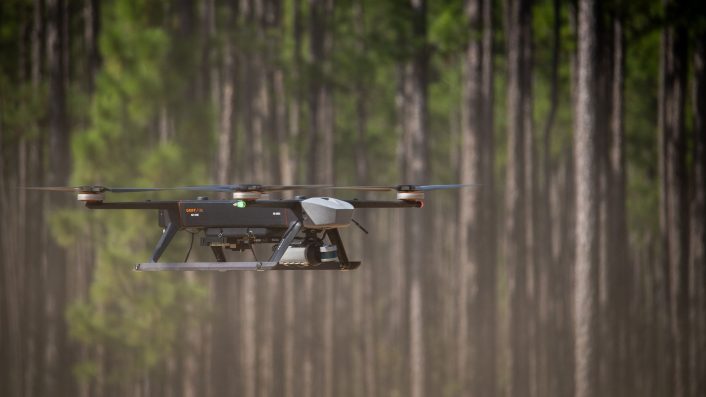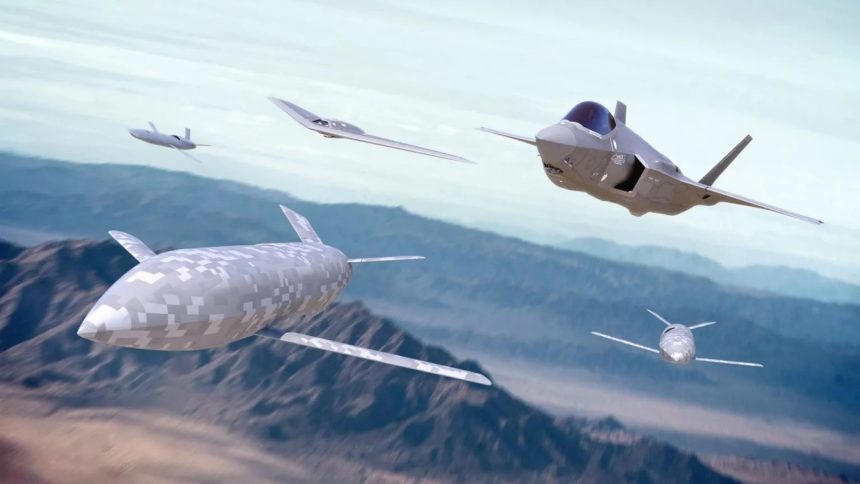General David Allvin advised against directly replicating the drones used in Ukraine for immediate deployment in the maritime theater of Far East Asia. He stated that 150 CCAs would be integrated within the next five years.
At the recent Military Reporters and Editors Conference in Washington D.C., U.S. Air Force chief General David Allvin differentiated between the emergence of drones in various flashpoints like Ukraine, the Middle East, the Pacific, saying how unmanned systems across these theaters are not necessarily comparable.
While acknowledging their military utility in Europe and West Asia, their application in the western Pacific against China is “different.” Air and Space Forces quoted Gen. Allvin: “The appearance of rapidly replicable, low-cost, mass airborne platforms offers both a threat and opportunity.”
Allvin distinguished between the simple and cheap unmanned systems that have posed an asymmetric challenge to Western coalition warships in the Red Sea, as well as Ukrainian and Russian military equipment in Ukraine, and the significantly sophisticated CCAs (Collaborative Combat Aircraft) that would be required to fight the PRC (People’s Republic of China).
The General cautioned against replicating the systems in Ukraine and immediately using them in the maritime theater in far-east Asia, as they would have to be customized for the geographical and techno-logistical needs of that theater.

The Air Force has been rapidly pushing CCAs with various U.S. defense majors. These systems are envisioned as wingman drones flying alongside manned fighters with roles ranging from strike, extended sensing, ISR and decoys in a mutually supporting role.
These cost about $25 million each according to ASF and the first designs have been unveiled, with Allvin saying 150 CCAs would be inducted within the next five years. The capability and mass these systems provide have led the service to reevaluate its future manned fighter needs.
Drone tech in Ukraine and Middle East
Ukraine has seen both Russia and Ukraine repurposing commercially available quadcopter-type drones for military use, ranging from UAVs strapped with warheads to strike armor, bunkers and infantry, to simple tactical overhead surveillance and artillery fire correction.
Drones have also contributed to a more strategic impact. Ukraine, in fact, has used cheap long-range drones striking as deep as 400 km into Russia, while Moscow has used Iran’s Shahed analogue Geran-2 drones to expend Ukraine’s Western-origin air defense missiles.
Ukraine has learned how to jam russian – Iranian drones without firing air-defense. pic.twitter.com/5XDLQTqo6i
— Ukraine Front Line (@EuromaidanPR) February 9, 2024
ASF said that “the proliferation of drones in the war in Ukraine has changed how many experts see the future of warfare.” Allvin, however, “cautions against overstating those lessons as the U.S. seeks to deter China and Russia and prepare for other major threats.”
The Aviationist reported how the mass fielding of such simple, unsophisticated UAVs by the Russian and Ukrainian militaries often saw the aircraft coming in contact with each other and trying to physically knock the other down. Episodes like these are being frequently reported, highlighting how these systems can be employed in a multitude of roles because of their versatility.
In the Red Sea, Gulf of Aden and the Bab-el-Mandeb strait, Houthi drones and cruise missiles tested Western navies with unremitting fires, causing crew fatigue and exhausting the warships’ armories. Iran has also deployed one-way attack drones against Israel, which shot them down with F-15s, F-16s and AH-64s.
A black-colored “Bober” long-range strike drone operated by Ukraine appeared in Astrakhan Oblast, southern Russia, today. pic.twitter.com/DLQRM2iDVR
— Status-6 (Military & Conflict News) (@Archer83Able) July 9, 2024
What defined the phenomenon, however, was the heavily skewed cost-to-benefit ratio of having to use multimillion dollar missiles and jets to shoot down projectiles worth only a few tens of thousands. The drones can strike targets with precision in a much cheaper way. Allvin said that this offers the opportunity “to deliver combat airpower, sensing, and communications in a different way.”
“The counter small-UAS threat is something that is certainly growing at a concerning pace,” said Allvin as quoted by ASF. The barrier entry to that is low, the ability to attribute [the attack] is low…We plan on really working on that and developing the counter small UAS to be able to counter the threats, not only here, but also the ones that we are facing overseas.”
– Israeli AH-64 Apache following a Hezbollah drone earlier today.
– Shot down by the apache 0:59 pic.twitter.com/tdeNKOsZFe
— kim høvik (@kimhvik2) November 2, 2024
‘Doesn’t apply to the western Pacific’
What works well in Ukraine, however, may have less utility in the western Pacific against China. “The question that we need to address as we look at how it might impact and find its way into our Air Force writ large is the utility across the geography,” Allvin said. “I would not want us to take what’s going on in Ukraine and … transport that immediately to the Indo-Pacific because of the nature of the tyranny of distance.”
Alluding to the massive oceanic distances before China, Allvin suggested this theater requires more advanced systems, in order to meet the air-sea war and the U.S.’s logistical challenges of keeping its forces supplied. Thus “inexpensive, precise and long-range…don’t often belong in the same text,” said Allvin.
“But we’re looking at it from both that opportunity and threat perspective on how we might integrate those into the force,” he added. Therefore, CCAs cannot be “quadcopter-style drones.” In fact, Allvin specified “they are certainly of a different class, and the idea is for them to be autonomous and collaborative with current systems.”
The AFRL (Air Force Research Laboratory) recently showed its common chassis concept for low-cost attritable drones. General Atomics’ XQ-67A OBSS (Off-Board Sensing Station) has also been developed as a part of the AFRL’s LCAAPS (Low-Cost Attritable Aircraft Platform Sharing) project.
The MQ-28A Ghost Bat being developed for Australia is expected to fly alongside its F/A-18E Super Hornets and F-35s. These are unmistakably meant for a war in the Pacific, where China is rapidly fielding its own wingmen drones like the GJ-11 Sharp Sword.
GA-ASI flies the new XQ-67A Off-Board Sensing Station for the first time.#XQ67A‘s first flight validates the “genus/species” concept focused on building several aircraft variants from a common core chassis to produce affordable combat mass.
Read here: https://t.co/5092GaiCiQ pic.twitter.com/bXBCmoMqOT
— GA-ASI (@GenAtomics_ASI) February 29, 2024
Conclusion
Some of these systems, like the LCAAPS, although “attritable,” are still costlier than the unsophisticated and often crude drones used by the Houthis or on the battlefield in Ukraine. Their tasks would also be far more complex, where they would launch air-to-air missiles against Chinese jets, while also being at least semi-autonomous.
Thus, the ‘cheap’, ‘attritable’ features here are within a higher and advanced spectrum of mission sets, which is different than merely swarming static, slow-moving targets like ground-launched air defense platforms, tanks or warships. This consequently requires advanced technology and therefore more money. To that extent, Allvin’s differentiation of the unmanned systems in these theaters is correct.
However, he also overlooks the fact that the U.S. Navy and the Taiwanese military are aligning their unmanned doctrines to acquire these very cheap aerial and sea drones to harass the PLA Navy. Thus what has been seen in the Red Sea is applicable in the Taiwan Strait. A degraded Chinese Navy directly impacts its strategic calculus, and isolates its air dominance, easing the job for U.S. fighters – and their wingmen drones.









